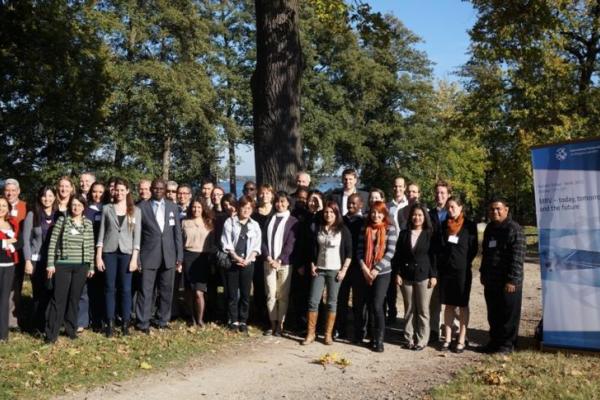Autumn School, Berlin 2012: "MRV - today, tomorrow and the future"
The First Autumn School of the International Partnership on Mitigation and MRV focused on the topic ‘MRV – today, tomorrow, and the future’. Twenty-four policymakers, practitioners and negotiators from environmental ministries, other ministries and agencies responsible for climate change issues met from 15 to 23 October 2012 in Berlin to further their knowledge and exchange experiences. During the eight workshop days, these participants from 23 developing and developed countries engaged in lively discussions and knowledge exchange with peers, and consulted international experts from the Organisation for Economic Co-operation and Development (OECD), the World Resources Institute (WRI), Ecofys, DNV Kema, the German Federal Environmental Agency and the Deutsche Gesellschaft für Internationale Zusammenarbeit (GIZ) GmbH.
The objective of the Autumn School was to empower participants to implement national processes for institutionalising MRV systems and to act as multipliers in their countries. As Brian Mantlana from the South African Department of Environmental Affairs, one of the founding members of the International Partnership on Mitigation and MRV explains: ‘We are here to learn from the experts and from each other.’
The agenda
The Autumn School covered a wide range of issues. In the first three days, the debates focused on the technical challenges presented by MRV and the establishment of greenhouse gas inventories. By the end of the first week, experts and participants shifted their attention to the MRV of NAMAs and the formal requirements for the biennial update reports. On the sixth day, finance stood in the spotlight; experts pointed out difficulties in measuring, reporting and verifying support, particularly with regard to private financial flows, and in coordinating different financing sources. At the end of the workshop, participants developed concrete steps for implementing MRV systems in their respective countries and shared existing good practice and lessons learned in working groups.
The four ‘E's’ of MRV
The debate turned out to understand MRV as in the own interest of countries: in order to use public budgets efficiently, to access international support, to track emissions and activities for reducing emissions, and to enhance credibility. Hence, four MRV functions were identified: (1) enforcement at national level; (2) engagement; (3) evidence; and (4) evaluation. However, as a pre-condition, countries must define clear long-term objectives and a vision for MRV – for emission reductions as well as for the benefits of MRV for the development of the own country. In this way, MRV can translate action into quantified emission reductions. MRV can also track who is doing what and when in terms of mitigating climate change and providing support for mitigation actions. MRV can thus also help to identify good practices in balancing the costs and benefits and in selecting indicators that can be monitored at reasonable cost and that accurately reflect changes and desired impacts. To this end, robust methodologies can ensure coherence between domestic and international systems as well as between top-down calculations and bottom-up aggregation.
The Autumn School was complemented by a discussion on Germany’s road towards a new energy era – the German Energy Transition – and an excursion to the German Federal Environmental Agency in Dessau. In addition, participants learned about a grassroots approach to mitigation and the use of renewable energies in the energy-autonomous village of Feldheim.
Initial lessons and next steps
The participants concluded that a functioning MRV system should build on existing elements and does not need to be perfect from the get-go. It makes sense to begin establishing a national MRV system using existing data and methods. Step by step, methods and data quality will improve over time. A learning-by-doing approach is the most feasible, especially in the context of NAMA implementation.
‘NAMAs will require MRV without being as bureaucratic as the rules of the CDM have been.’
Killian Wentrup, Perspectives
Perhaps the most significant outcome was that the Autumn School provided a platform for communication between negotiators and implementers. It emphasised the importance of this exchange and the opportunity for bilateral and mutual learning related to technical needs for the negotiations and vice versa. As a consequence, the International Partnership on Mitigation and MRV is in a position to facilitate two-directional capacity development.
Participants also highlighted the key role of the Partnership as a basis for a global MRV network. They suggested establishing a matching platform to exchange expertise with collaboration partners and identify and disseminate good practices and success stories.
The main outcomes of the Autumn School were presented during the Partnership meeting held alongside COP 18 in Doha. A detailed documentation can be found in the download column on the right.
Flashlights
“That workshop gave us fantastic examples from different countries on lessons that we can learn from various stages of implementation.”
Gil Proaktor, Israel
"Hearing examples from different countries in terms of what are the existing mechanisms in place in order to do MRV, NAMA and tracking climate finance was really helpful, because you see a more holistic picture of what is happening around the globe, what are the existing efforts and what can be transferred in terms of your own national systems."
Rachael Seso, Philippines
“It fast forwarded months of reading in just a week.”
Lea Kai, Lebanon
"The added value is having together all kinds of opinions and perspectives, from different types of countries, circumstances, organisations and having the best standards for doing something and the problems that all of us are facing and also the ways that all of us are trying to resolve it."
Fatima Lopez, Mexico


